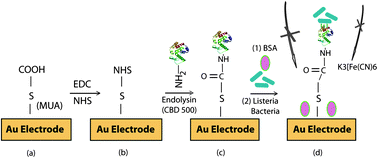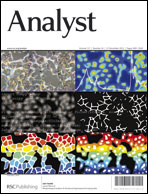A bacteriophage endolysin-based electrochemical impedance biosensor for the rapid detection of Listeria cells
Abstract
The objective of this study was to develop a biosensor using the cell wall binding domain (CBD) of bacteriophage-encoded peptidoglycan hydrolases (endolysin) immobilized on a gold screen printed electrode (SPE) and subsequent electrochemical impedance spectroscopy (EIS) for a rapid and specific detection of Listeria cells. The endolysin was amine-coupled to SPEs using EDC/NHS chemistry. The CBD-based electrode was used to capture and detect the Listeria innocua serovar 6b from pure culture and 2% artificially contaminated milk. In our study, the endolysin functionalized SPEs have been characterized using X-ray photoelectron spectroscopy (XPS). The integration of endolysin-based recognition for specific bacteria and EIS can be used for direct and rapid detection of Listeria cells with high specificity against non-Listeria cells with a limit of detection of 1.1 × 104 and 105 CFU mL−1 in pure culture and 2% milk, respectively.


 Please wait while we load your content...
Please wait while we load your content...